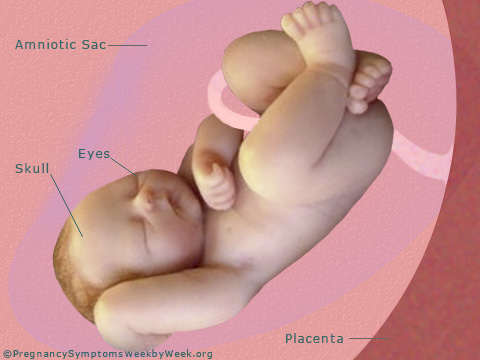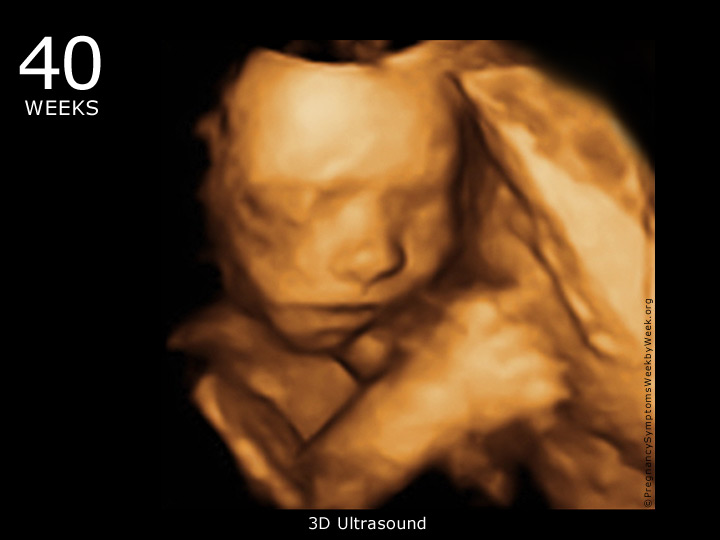40 Weeks Pregnant ─ Pregnancy Symptoms
Your 40th Week Marks the End of Your Pregnancy and the Birth of Your New Family Member!
6 DAYS TO GO. . .
COMMON PREGNANCY SYMPTOMS FOR WEEK 40
In this final week of your pregnancy, it will feel as though the whole world is awaiting the news of your baby's birth. This can be overwhelming especially if you go overdue. If you become frustrated by all the repeated communications you could rely on another person to field the calls for you or setup a voice message stating that you will be in contact with an announcement just as soon as there is any news.


Fetus Size
Your baby is about the size of a pumpkin during week 40.
LENGTH: 20.58 in / 52.2 cm
WEIGHT: 7.98 lb / 3619.7 g
View Weekly Growth Chart >>
WHAT'S GOING ON INSIDE?
The Eyes are fully formed but are not able to focus after birth. It will take a few weeks for the eyes to fully develop before your baby will be able see you and its surroundings clearly. Caucasian babies are usually born with blue eyes and their true eye color may not reveal itself for weeks or months. African and Asian babies usually have dark grey or brown eyes at birth and change to a true brown or black six months to a year after being born.
The Placenta will separate from the uterus wall after you give birth. You will most likely feel additional contractions and your doctor may help deliver it by pulling on the umbilical cord.
The Amniotic Sac will rupture once you go into labor and the amniotic fluid that has cushioned your baby for many months will flow out of your vagina. This is also known as your water breaking.
The Skull will remain soft and pliable for delivery so they can overlap as they pass through the birth canal. This may lead to your baby’s head having a cone appearance for the first several days of life. Your baby will have two soft spots, or fontanelles, on their head which allow for an easier delivery. The back fontanelle will harden between the 3rd and 5th month and the front fontanelle will become hard between the 7th and 16th month of life.
Over the next week or two you may experience false labor. This may include deep, painful twinges, Braxton-Hicks' contractions or regular contractions that last for a short period then stop. It is easy to misjudge these contraction for the real thing and you may find yourself rushing to the hospital. Losing your mucus plug or your water breaking are both signs of labor. However, it is common for neither of these events to take place until labor is established. The definite way to know your are in labor is when your contractions are regularly occurring every 15 minutes. Real contractions will get longer and stronger over time. When your contractions are five minutes apart and lasting about a minute each, it is time to go to the hospital.
Your Water Breaking
A common concerns for women late in pregnancy is that their water will break in public. Only a small percentage of women experience the rupture of the amniotic sac before they go into labor, so chances are you'll have plenty of warning and you may possibly be at the hospital already. Although there is a small possibility of a big watery mess, the reality is that the amniotic fluid will likely trickle out, colorless and odorless. This is because most baby's are head down (95% of the time) allowing their head to press against the cervix, preventing much of the fluid from escaping.Once your water breaks you will want to call your practitioner, but keep in mind that your labor contractions may not begin right away, and labor may not start for another 12 to 24 hours. (You won't run out of amniotic fluid in the meantime — your body continues to produce it right up until delivery.) And if your contractions don't start on their own within 24 hours, your practitioner will likely induce you to get your labor started.
When your baby is born, they will be evaluated and graded on the following factors (0 to 2 points each): activity and muscle tone, pulse/heart rate, grimace response known as "reflex irritability”, appearance/skin coloration and respiratory breathing rate/effort. The total sum will determine your baby's "APGAR score" which is an initial measure of their health. On average, healthy babies have an APGAR between 7 and 9.
<< Week 39 - PREVIOUS | Week 40 |


